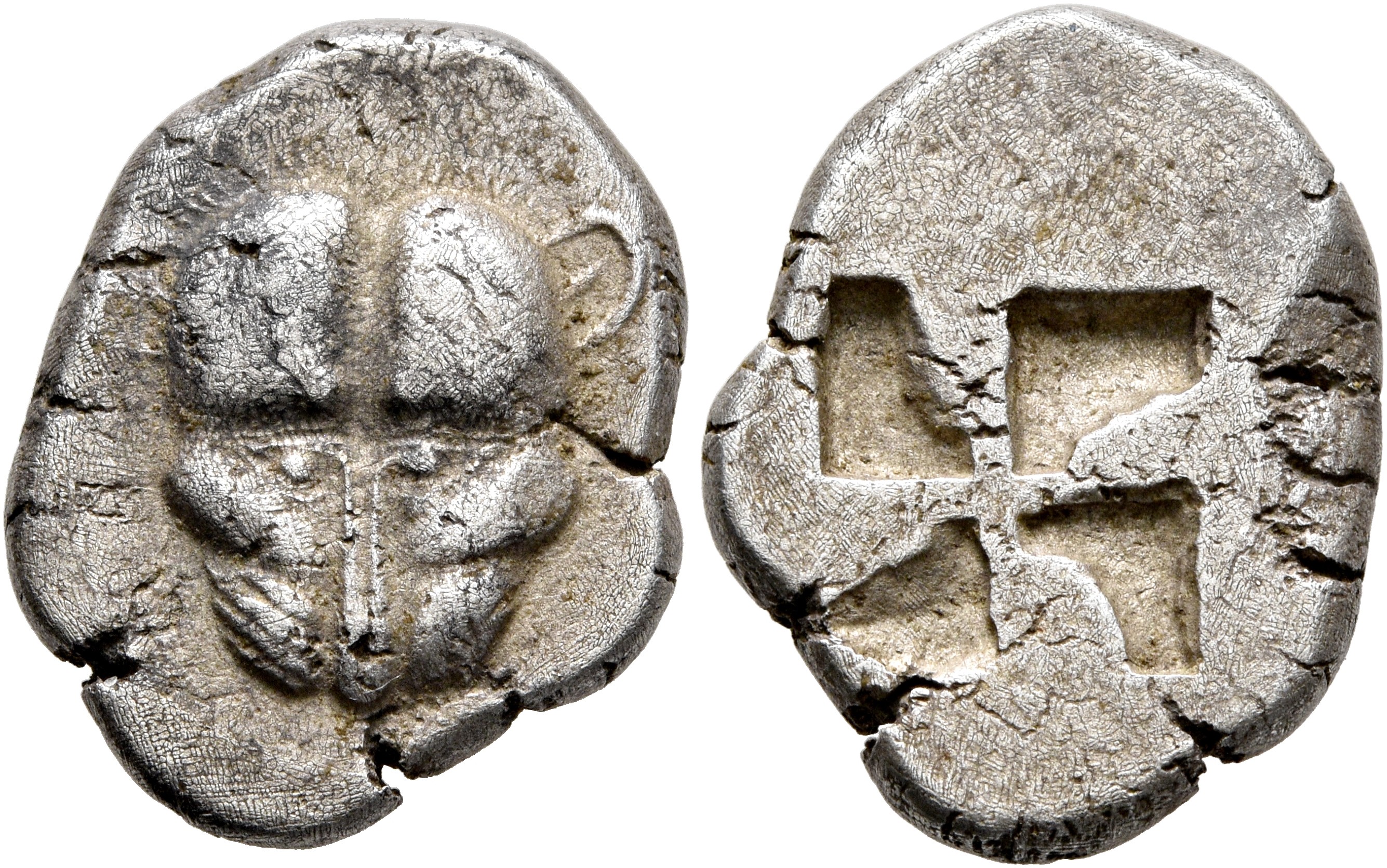Panticapaeum, silver, drachms (550-410 BCE): Difference between revisions
From SILVER
m (Callatay moved page S 890 - Panticapaeum, silver, drachma, 550-410 BC to Panticapaeum, silver, drachms (550-410 BCE)) |
No edit summary |
||
| Line 1: | Line 1: | ||
{{Die Study | {{Die Study | ||
|Image=Panticapaeum_drachm_510.jpg | |||
|Image reference=https://pro.coinarchives.com/a/lotviewer.php?LotID=1897430&AucID=4448&Lot=2087 | |||
|Obverse description=Head of lion facing. | |Obverse description=Head of lion facing. | ||
|Reverse legend=ΠΑ (type X) ; ΠΑΝ (type XI) ; ΠΑΝΤ(Ι) (type XVII) ; ΑΠΟΛ (type XXXV) | |Reverse legend=ΠΑ (type X) ; ΠΑΝ (type XI) ; ΠΑΝΤ(Ι) (type XVII) ; ΑΠΟΛ (type XXXV) | ||
|Reverse legend language=Greek | |Reverse legend language=Greek | ||
|Reverse description=Quadripartite incuse square with windmill pattern | |||
|Mint=Panticapaeum | |Mint=Panticapaeum | ||
|Ancient region=Bosporus | |Ancient region=Bosporus | ||
| Line 13: | Line 16: | ||
|RQEM reference=RQEM ad. | |RQEM reference=RQEM ad. | ||
|RQEM reference number=890 | |RQEM reference number=890 | ||
|Die study reference= | |Die study reference=Frolova 2004, p. 17-42, no. 1-2, 31, 293-297, 312, 400, 539b (types I, II, X, XI, XVII, XXXV) | ||
|Coin series reference=MacDonald 2005, n° 1/2; HGC 7, n° 26 | |||
|Coin series web reference=https://greekcoinage.org/iris/id/panticapaeum.macdonald.2005.1-5.7 | |||
|Number of obverse dies=11 | |Number of obverse dies=11 | ||
|Number of singletons=10 | |Number of singletons=10 | ||
|Number of reverse dies=11 | |Number of reverse dies=11 | ||
|Number of coins=14 | |Number of coins=14 | ||
|Workstation=Most likely one single workstation | |||
|Purpose=Likely military | |||
}} | }} | ||
{{Distribution Item | {{Distribution Item | ||
Latest revision as of 18:56, 6 July 2023
550 BCE - 410 BCE Silver 4,263 kg
Description
| ObverseInscription or printing placed on the obverse.: | Head of lion facing. |
| ReverseInscription or printing placed on the reverse.: | ΠΑ (type X) ; ΠΑΝ (type XI) ; ΠΑΝΤ(Ι) (type XVII) ; ΑΠΟΛ (type XXXV) (Greek).Quadripartite incuse square with windmill pattern |
Mint and issuing power
| MintIdentifies the place of manufacture or issue of a numismatic object.: | Panticapaeum | Ancient regionAncient region.: | Bosporus | Modern countryModern country: Russia (Crimea) | AuthorityIdentifies the issuing power. The authority can be "pretended" when the name or the portrait of X is on the coin but he/she was not the issuing power. It can also be "uncertain" when there is no mention of X on the coin but he/she was the issuing power according to the historical sources: |
Chronology
| FromIdentifies the initial date in a range assigned in a numismatic context. | 550 BCE | toIdentifies the final date in a range assigned in a numismatic context.. | 410 BCE | PeriodTime period of the numismatic object.: Archaic and Classical |
Physical description
| MetalThe physical material (usually metal) from which an object is made.: | Silver |
Median weightMedian of the weights of numismatic objects (in grams). in grams | 5.30 | DenominationTerm indicating the value of a numismatic object. Examples: tetradrachm, chalkous, denarius.: | drachma |
StandardStandard.: |
Image

Panticapaeum_drachm_510.jpg [1]
References
| Die study referencePublication of the study: | Frolova 20041Frolova 2004, p. 17-42, no. 1-2, 31, 293-297, 312, 400, 539b (types I, II, X, XI, XVII, XXXV) | ||
| Coin series referenceReference to coin series study: | MacDonald 20052MacDonald 2005, n° 1/2, HGC 73HGC 7, n° 26 | ||
| Coin series web referenceCoin series web references: | |||
Obverse dies distribution
| FrequencyFrequency of specimen in distribution. ᵖ | Number of obversesNumber of obverse dies. ᵖ (o) | % (o) | Number of coinsNumber of coins. (n) | % (n) | Die nameName(s) of the die(s). |
| 1 | 10 | 90.91 | 10 | 71.43 | |
| 4 | 1 | 9.09 | 4 | 28.57 | |
| Total | 11 of 11 | 100 | 14 of 14 | 100 |
Reverse dies distribution
no distribution is available
Quantification
| Number of obversesNumber of obverse dies. ᵖ (o) | 11 | Number of singletons (o1)The number of singleton coins. ᵖ | 10 |
| Number of reverse diesNumber of reverse dies. (r) | 11 | Number of coinsNumber of coins. (n) | 14 |
| Coins per obverse dieNumber of coins per obverse die. (n/o) | 1.27 | Coins per reverse dieNumber of coins per reverse die. (n/r) | 1.27 |
| Reverse per obverse ratioRatio of obverse dies divided by reverse dies. (r/o) | 1 | Percentage of singletons (o1)number of coins (n) divided by the number of singletons (o1) ᵖ | 90.91 % |
| Original number of dies (O) (Carter 1983 formula)The estimation of the number of coins according to Carter 1983 ᵖ | 40.22 | Coins struck if 20,000 as average productivity per dieCoins made if the average productivity for obverses (according to Carter) is 20,000. ᵖ | 804,400 |
| Original number of dies (O) (Esty 2011 formula)The estimation of the number of coins according to the singleton formula in Esty 2011 ᵖ (O) | 51.33 | Survival rate if 20,000 as average productivity per dieSurvival rate if average productivity is 20,000. ᵖ | 0.00002 |
| Coverage (o = % of O) (Esty 1984 formula)Esty 1984 - coverage (% of O) ᵖ (o = % of O) | 28.57% | Die productivity if survival rate 1/2,000Average productivity if survival rate is 1/2,000. ᵖ | 696.17 |
| Weight of silver (in kg) if 20,000 coins per die (O = Carter formula)Carter 1983 * Median weight * 20000 (*10 if gold or electrum) ᵖ | 4,263 kg <br /> 4,263 kg | Die productivity if survival rate 1/5,000Average productivity if survival rate is 1/5,000. ᵖ | 1,740.43 |
Remarks
Most likely one single workstation Likely military